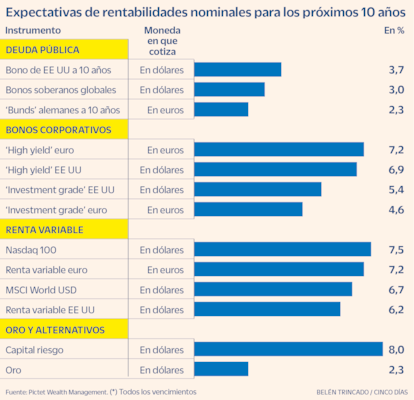The world has faced enormous challenges in the past three years: a pandemic, a supply crisis, the outbreak of war in Ukraine, the energy crisis, and hyperinflation, which have caused profound changes in the global economy. The economic and political framework of the past ten years is no longer there and investors will have to adapt and redefine their long-term investment strategy.
Given this scenario, fixed income takes center stage, so much so that the expected return on corporate debt will be very close to the expected annual return of the US stock market in the next decade. These are the conclusions of the report horizonon the 10-year macroeconomic and global market outlook, prepared by Pictet Wealth Management experts.

The 10-year annualized nominal return (inflation discounted) projections estimated by the Swiss company indicate that fixed-income assets will be a very attractive alternative to equities and will return to investors’ portfolios. Pictet expects the nominal 10-year annualized yield on US equities to be 6.2%, while the yield on investment-grade US corporate bonds will be 5.4%, based on estimated dollar yields. In other words, the risk of investing in the world’s largest stock market will be rewarded with one more profit point compared to higher-quality corporate debt.
An investment in the NASDAQ 100 will guarantee higher returns over the next decade, up to 7.5%. On the other hand, betting on MSCI World equates to a return of 6.7%. However, corporate bonds high fruit, or speculative grade, would have a very similar return, 6.9% in dollar terms. So the clear commitment to fixed income from rising interest rates will have a long-term horizon.
In the Eurozone, the stock market forecast return for a decade is 7.2%. By Pictet’s estimates, the same yield will be European junk corporate bonds. The yield on investment-grade European corporate debt will be 4.6% annually over the next decade. For a euro investor in European assets, the difference in favor of the stock market in this case will be greater, amounting to an additional 2.6 profit points per year, compared to the highest quality corporate debt.
Thus Pictet concludes that sovereign and corporate bonds “should form a structurally larger portion of asset allocations and returns without increasing portfolio risk parameters”. Convinced that inflation and rates will be higher than in the past, analysts actually expect long-term sovereign bonds in developed markets (excluding Japan) to continue to offer an attractive yield: 3.7% in dollars for 10-year US Treasuries, versus 2.3% in euros for Dams Germans.
“In recent years, investors have been turning to riskier fixed-income assets to find attractive returns,” they noted in the report. Given these assumptions, traditional 60/40 portfolios (equities and debt, respectively) are once again attractive.
In addition to the renewed weight that Pictet expects to bring back fixed income in portfolios, the biggest source of profitability for the next decade will be in venture capital, at 9.4% annually in dollars and more restricted to institutional investors.
Poor growth
To derive these projections, Pictet starts from the macroeconomic scenario of a slight overall slowdown in growth, which would be about 3.1% on average in the next decade, according to estimates. A number that experts consider weak, and attribute it to “the maturation of some emerging economies, especially China, demographic issues and geostrategic competition.”
The Swiss company calculates that the annual increase in GDP for 10 years in the eurozone will be around 1.5%, while core inflation will remain on average at 2.3%, above the 1.4% recorded before the pandemic, but in line with 2%. The goal of the European Central Bank (ECB). Of course, the ECB will keep the deposit rate at 2.5%, compared to the 4% it could reach in this cycle of increases.
In the US, annual GDP growth will average 1.6% annually in the next decade, and annual CPI will average 2.7% (versus 1.8% pre-Covid). Experts also believe that the Fed’s monetary policy will be more relaxed and interest rates will drop to 2.5%.
An increase in the money price, which will remain higher compared to pre-pandemic levels, will affect future cash flow valuations. “So higher discount rates mean a structural decline in stock valuations going forward,” the analysts say.
The gold trap and bright prospects for India
negative real return. The precious metal is an asset of refuge in times of high inflation. However, according to Pictet estimates, which envision average inflation rates of 3.8% globally over the next decade, gold will have a negative real annual yield. Ten years from now, the real yield on gold will be -0.3%.
Growth and inflation in Asia. Pictet experts believe that China’s growth potential over the next few years will be affected by an aging population, slower urbanization and deglobalisation. For this reason, they estimate that the average annual growth of the country’s economy will be 3.9% in the next ten years, while inflation will rise to 2.9%. In the case of Japan, real GDP growth will be 1%, given that the monetary policies of the country’s central bank will gradually normalize. On the contrary, India’s working-age population will continue to increase and its GDP will grow at an annual rate of 6.2% until 2032, according to Pictet estimates. So India will become, by far, the obvious engine of global growth.
Follow all information for five days in FacebookAnd Twitter And linkedinor in Our newsletter Five days agenda
Five days agenda
The most important economic dates of the day, with keys and context to understand their scope

“Beeraholic. Friend of animals everywhere. Evil web scholar. Zombie maven.”
